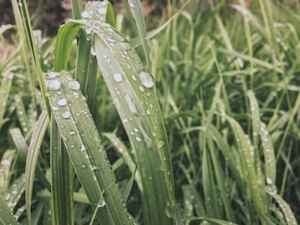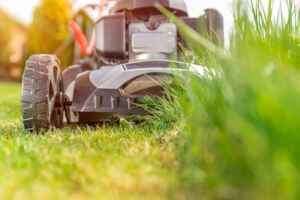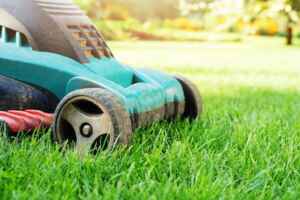Mowing Your Lawn After It Rains
Mowing your lawn after rain is something many homeowners do, but not everyone knows how long they wait to mow after rain.
So, can you mow wet grass after it rains?
It normally takes 1-2 hours for rainwater on a lawn to soak into the ground. Most professionals recommend 2 hours wait time after rain before cutting grass.
This waiting period allows enough time for rainwater that sits atop the blades of grasses to be absorbed into the soil below. During this time it might be beneficial not only for the safety of your mower and yourself but the health of your lawn.
Mowing Heavily Soaked Lawns
By cutting rain-soaked grass you can damage the grass blades which may hinder the ability of rainwater to be absorbed into the soil. Rain is one of few sources that deliver just what a plant needs (rain delivers natural fertilizer such as nitrogen, phosphorus, and potassium.
Mowing too soon might result in browning or dying spots developing on parts of your lawn due to not getting enough water from rain.

Mowing While It Is Raining
It is important to never mow while it is raining. This can cause many concerns for safety. Lawn mowers are mechanical, therefore they have electrical systems within them. If these systems get heavily soaked by rain, it can pose a safety threat. In addition, this can cause major damage to your lawn mower. It may be tempting to some, but it is important to listen to mother nature and wait it out. Always wait until after a few hours of dry weather before proceeding to mow the lawn.
Watch Out for Flooding
Another thing you should keep an eye out for is if there are any possible flood risks near where you live. Floods cause a lot more damage than rain alone because floodwaters become a mixture of rainwater and sewage, car oil, and other harmful chemicals. Flooding can increase the likelihood of your mower hitting a foreign object while you are cutting which will cause damage to your mower.
Rainwater is lighter than regular groundwater. Because of this, floodwaters usually run down slopes towards valleys and between streets. Here it mixes with rainwater from roofs on homes after people have been told not to clean their rain gutters out.
If there are any areas around where you live that might flood, better wait until rain or floodwaters have gone before mowing just to be safe.
Quick Rainfall
As a general rule of thumb, you should wait at least 1-2 hours after the rain ends before going outside to cut grass depending on what type of lawn you have and how often it rains in your area.
A light rain lasting five minutes is not going to be enough rainwater to puddle and create a flood risk while a heavy rain lasting an hour might. It’s all about the rainfall that falls in your area and how often it rains.
Using Rain Sensors
If you are using some type of rain sensors on your home to determine when you should start mowing after rain, we suggest having rainwater sensors installed. This is so rain can be measured based on how intense it is instead of how many hours it has been since the rain stopped falling. This is because rain duration plays such a big role in lawn safety.
Installing rain sensors on homes ensures safety during periods of heavy rainfall because flooding becomes a bigger issue when rainfall is mixed with sewage or septic runoff.
Before the rain begins to fall, you can anticipate rain by gathering rain sensors. This will help to be ready for when it starts pouring because rainfall intensity levels are easily measured while the time between rain spells is not.
Mowing Long Grass vs. Short Grass
Some homeowners like their lawns very short while others prefer them longer. There are advantages and disadvantages for both types of individuals when cutting grass after rain.
With short grass, rainwater will not have enough time for rain-harming pesticides or fertilizers to sit atop the blades of grass. If rain does not stay for a long time, rainwater will make a quick effort to be absorbed into the soil and this might cause browning or dying spots on shorter grasses that have been cut recently.
 Mowing Long Grass After Rain
Mowing Long Grass After Rain
If you have a long grass blade length then rain might not be a good time to cut. Rainwater mixes with the fertilizer or pesticides you have been using on your lawn. When rain falls at a higher intensity, rainwater has more pesticides in it. Rainwater is a form of pesticide rain that can be harmful to the blades of grass.
Mowing Short Grass After Rain
If you have a short grass blade length then rain can be a wonderful thing for cutting. This is because rain will wash away dead blades of grass while simultaneously revitalizing anything growing in your lawn.
Shorter blade grasses have smaller pores which means rainwater has less time to sit atop the grass before being absorbed into the soil below. If you happen to have a lot of rainfall in your area and there is still some flooding going on, better wait until rain waters have subsided before mowing just to play it safe.
What Happens If You Do Not Mow After Rain?
When it comes down to it, not mowing after rain can leave browning or dying spots on parts of your lawn. Choosing the wrong rainwater blade length for your lawn might make rain seem like it’s not the right time to cut. If the rain keeps falling and it rains hard enough, you might forget about waiting after the rain ends before cutting the grass.
You may prefer to mow when you have had enough of standing in puddles instead of waiting an extra hour or two because there is always something that needs to be done inside…and outside the home.
Tips To Remember For Mowing After Rain
If you do decide to wait until after it rains before mowing, remember that 1-2 hours after rain ends should be sufficient time to ensure any flood risks are gone. So, take care of your lawn by being cautious!
- Keep in mind how often you have rainfall where you live. If flooding is a concern, better safe than sorry and wait another day if rain doesn’t end soon to save your mower from being damaged.
- Always choose a rainwater mowing blade length that’s good for your lawn. Rain won’t harm the health of your lawn. It will give you great measurements of how healthy parts of your lawn are.
- Using rain sensors around where you live allows rain to be measured based on how much rain has fallen. Instead of trying to judge it by the time between rain periods ending which is very unreliable as we all know how different rainfall intensity levels can be around where we live.
 Mowing Once The Rain Has Stopped
Mowing Once The Rain Has Stopped
After all that is said and done, what happens if your lawn is already wet when you decide it’s finally time to mow the grass? Well, there are some simple tricks out there like using a stick or plastic baggie filled with water so rain doesn’t get in your mower blades. This keeps the engine running at its best possible performance level.
Keep in mind that after the rain stops falling, your grass can become slippery making it necessary to put on shoes before walking outside just in case.
If you don’t have any rainwater sensors installed on your home, rain might still be on the ground when you decide it’s time to mow. Rain sensors prevent rain from being a pain in the butt because rain can interfere with a lot of things around where we live.
In Conclusion
If rain is the only thing going on outside and there isn’t anything else interesting happening in your area, better not risk breaking down your mower by cutting through rainwater blades without rain detection equipment installed or even if rain has stopped falling for that matter.
When it comes down to it, waiting after the rain ends before cutting lawns is always best but sometimes it just doesn’t feel right spending another day locked inside when all you want to do is go outside and have some fun! If flooding becomes a concern, rain sensors can help keep rain from causing harm while rain waters won’t get in the way of mowing the grass.
After the rain ends always make sure to put on shoes before stepping outside, watch out for slippery conditions caused by rain, and measure rainfall using rain detection equipment installed around where you live. It is easier than judging rainfall intensity levels based on the time between rain spells.

